
Naming products is no easy task.
You’ve got your product and a whiteboard full of random phrases and ideas being tossed around.
Some names sound ok, maybe a few seem like a good fit, but no one on your team can agree on a winner.
So how do you choose the right name for your product?
Here’s where keyword research comes into play!
By understanding what people are searching for, you can optimize your product name to better meet their needs.
Not only that, you’ll also increase the odds that they’ll find and buy your product.
Stressed? Don’t be.
I’ll show you the ins and outs of product naming to make the process a breeze.
What Makes a Good Product Name?
In general, you want your product name to be easy to remember, easy to understand, and easy to say!
Think about it.
If I can’t even pronounce your product’s name, how am I going to remember it?
And if I can’t understand what your product does through its name, I’m probably going to go see what the competition has to offer instead.
So before you release a product, it’s always a good idea to research online marketing challenges that could arise.
If you don’t, it could limit your team’s ability to make the right branding strategy. On the other hand, using SEO hacks to discover your next brand name works surprisingly well!
You likely already understand the importance of SEO, and the data backs you up. A study that analyzed billions of Google searches discovered that the first three organic results had a combined 44.5% click-through rate. But how can SEO help you name your product?
Two words: search intent.
When someone searches for something online, their intentions become clear through the words they use.
Looking for reviews? You’ll probably add the word “best.” Searching for someplace to eat? The words “near me” might be used. Search engines like Google have gotten great at inferring user intent based on the queries they enter and the context around them.
The point is, you can also search your own product’s name or product category and see what keywords the top ranked results share. Those first few results likely have things in common. Are your potential customers looking for a product that has certain qualities, like increased speed or strength? That might be a sign to incorporate similar words into your brand.
Don’t make the mistake of only looking for intent in the top search results. At least for Google, you can check out related searches and what “people also ask.” Both of these provide insights into what your customer base is thinking when it comes to your product.
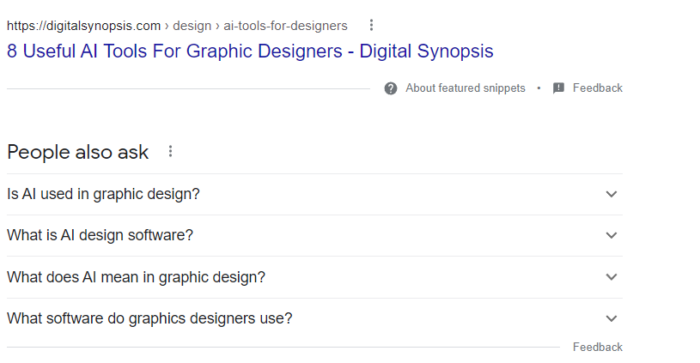
Here are a few branding tips to think about when you name your next product:
- Make it Relevant
Ask yourself, what category does your product fall under? It’s likely a term that people also search for when looking for similar products.
That’s why you should include as many of your category names in the name of your product whenever possible.
Product names are also usually cited as anchor text in online articles, so including a category in the name can lead to more qualified clicks to your page. This is just one way of leveraging SEO to build your brand.
A clever example of this is the brand name for a project management tool for businesses called MOE Assist. This play on words hints at “more assistance” for projects by using MOE Assist.
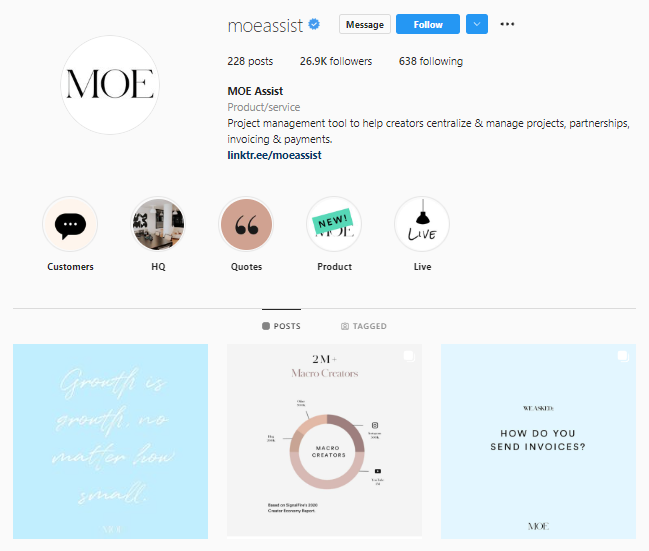
- Use Search Engines/Tools
Have trouble coming up with keywords in your field?
Ubersuggest is a useful keyword generation tool for honing in on the perfect name. It’s easy to use with a smooth interface and offers a ton of extra information about every keyword. Ubersuggest offers suggested keywords to use instead, as well as related words, SEO difficulty, and volume and more.
One cool bonus feature of Ubersuggest is each keyword search result comes with a list of content ideas that could give you a boost in SERPS (search engine results pages).
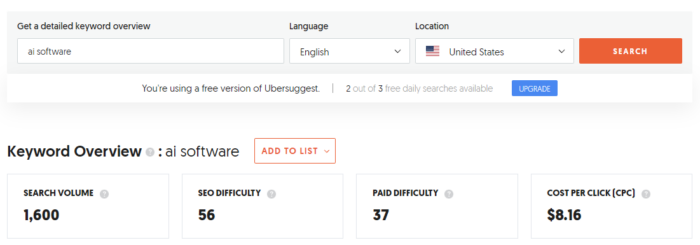
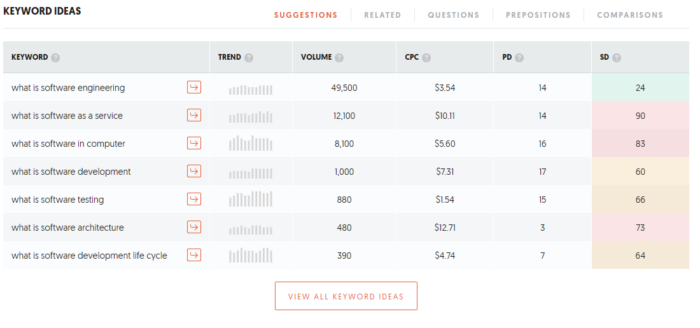
YouTube is also an excellent resource, as it is the second largest search engine in the world. To find popular keywords on this platform, use YouTube’s search bar to enter in your brand name ideas. YouTube’s auto-suggest feature will activate and show you a drop down list of related searches.
Google Ads can help as well, providing access to data on individual keywords, their search rates and suggested alternative words.
- Stay Positive
You’ve probably heard of the phrase “guilty by association.” Product names are bound by the associations they elicit.
How many people would buy an Apple product if the company was named after something sour, like a lemon?
Words and meanings can shift across international lines. If you plan on selling your product all over the world, think about how your name will resonate in different cultures. You’d be astonished to find out how many corporate brands alter their product names in different regions. For example, in China Heineken Beer is instead called Xi li, which translates to “happiness power.”
- Don’t be Ambiguous
Sure, that random word may sound catchy, but if it bleeds into another category then you end up diminishing your ranking on the organic SERPs. Ambiguous words are open to more than one interpretation. Let’s say you are starting a make-up company and use the word “Compact” in your name. While it can mean a make-up holder, it’s also used for all sorts of products trying to market a small size.
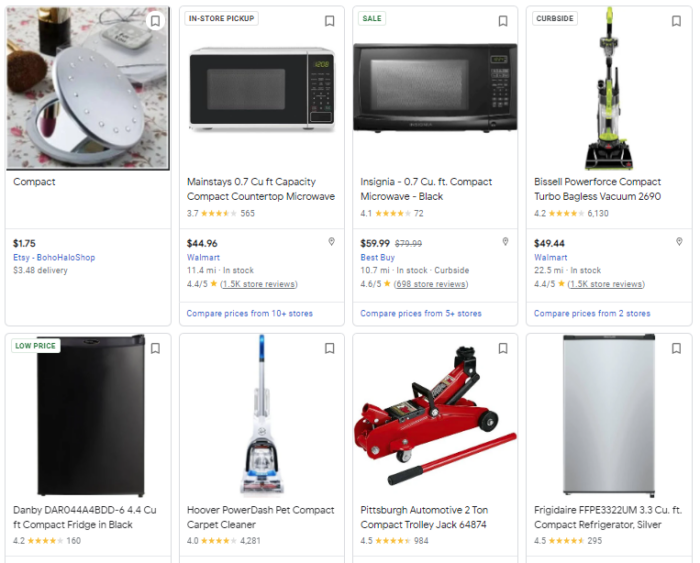
Keep your product names category-specific and direct.
Product naming may not be rocket science, but it does take time to learn how to do it right! Learn more about why SEO is so important for your brand.
Scout the Competition
It can never hurt to take a peek at the competition. Look at the reviews left for your competitors. It will tell you all about their strengths and weaknesses from the perspective of their audience. What are the most common complaints you see? You can use those reviews to differentiate your own product from the competition.
Dive deep into their publicly available data, like social media accounts and websites. What unique features do their products have?
Product Naming Success Examples
Look no further than two of the biggest tech giants, Microsoft and Apple, for examples of great success stories in product naming.
Take Microsoft. Windows was their flagship product of the 90s and still has 76% of the global market share held by operating systems in 2022.
So what made them choose the name Windows?
Well, around the time that Windows launched, all graphical user interfaces (GUIs) were being described as “windowed systems.” Rather than becoming yet another windowed interface, Microsoft flipped the script by claiming the window name for themselves.
In turn, this positioned Windows as the category definer instead of a reinforcer, with other companies now using Microsoft’s branded name to describe their interfaces.
Another great example of successful product names is Netflix. Simple, direct, and includes the category in the title: what more could we ask for?!
By combining the first half of the word “internet” with a slang word for movies, Netflix says what it is with minimal effort.
Find What Your Audience Wants and Thinks
You can save time and money by learning from your target market what they want, rather than guessing.
If you have a client email list, send them a survey and ask them a few questions to get to know your audience better.
Once you have results, look for repeating themes and common answers. Use these responses to reword your product name appropriately.
Don’t have an email list? Use your social media accounts instead!
With the average amount of time spent on social media at 2.5 hours per day, there is a lot of data available to comb through.
Get insights on your followers by looking at what they kept watching and what they clicked on. Post mini-polls to gauge interest. Find audience members who are more engaged with your page and send a direct message.
Asking a few questions from engaged followers can give valuable feedback from the people most interested in your products.
Future-Proof Your Product Naming Strategies
You’ve jumped through all the SEO hoops and finally have a product name worth using. Secure that name for ages to come!
To avoid any future SEO or social ramifications, double-check to see whether someone has already taken your planned social media profile name.
If you don’t want to be associated with somebody who has a negative reputation, this is critical, particularly if there’s already someone out there with the same account name as your product.
Future-proof your product names by claiming social media accounts with your product’s name on all the main platforms. In addition, check web domains with your product name as well. If they are available, buying them is a good way to protect your brand name’s reputation.
FAQs
How important is my product name?
Your product name is vital to the success of your product! 77% of consumers buy products based on the name instead of the product itself. The name is one of the first things that potential customers will see. Product names without any association to the product’s category can make it hard to find on search engines. Names with negative associations to other words and social media accounts can hinder sales.
How do I know I am naming my product something people want?
By researching your audience through surveys and data analytics, you can help ensure that the product name you choose is something that people want.
Conclusion
The creation of catchy and unique product names doesn’t have to be hard.
By leveraging SEO to build your brand, you can come up with a name that speaks to your audience!
Remember to pick a brand name that is relevant, has positive associations and is unambiguous. If you can include a category title in your product’s name, all the better.
With the right name for your product, you’ll rise in the SERPs.
Higher rankings lead to higher traffic, which leads to more revenue.
How will you leverage keywords to help your next product soar?
from Neil Patel https://ift.tt/LnopfUq

No comments:
Post a Comment